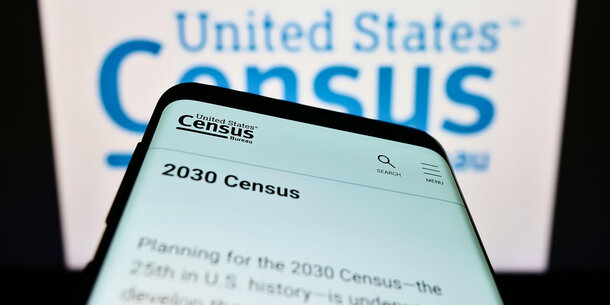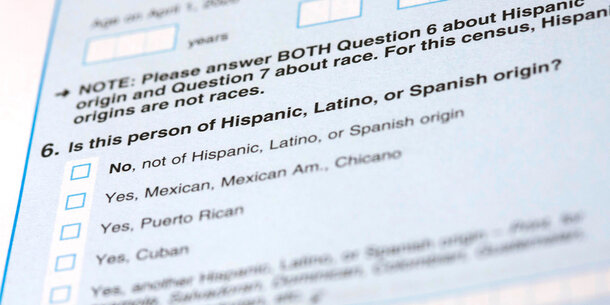The census is a cornerstone of American democracy. The results of this constitutionally required, once-a-decade count of every person living in the United States dictate how seats in the House of Representatives are divided among the states, how state and local governments draw electoral districts, and how more than $1.5 trillion annually in federal funds is distributed for essential services such as health care, food assistance, and education. At its best, the census offers an authentic picture of who we are as a diverse and growing nation.
The 2020 census struggled. It faced a barrage of obstacles, from executive interference to chronic underfunding to the Covid-19 pandemic. In the face of these challenges, it ultimately failed to reach 18.8 million people — more than 5 percent of the country’s population. footnote1_I4Z3MinpdhRsNbDEGzyd5lFv4S4xFhTki4wYHQTK4U_sLTMBokUduNO1 U.S. Census Bureau, “National Urban League Update” (PowerPoint presentation, 2020 Census Post-Enumeration Survey and Demographic Analysis, March 29, 2022), 52, https://www.census.gov/content/dam/Census/newsroom/press-kits/2022/20220329-presentation-nul-briefing.pdf. What’s more, the census once again disproportionately undercounted people of color, with the Latino undercount rate more than tripling from the prior decade. footnote2_nKqcwcpm-OSsFgTDWvw2Ovs014FcjX-owwQvKquQ2Fw_wb8ZyANDhfFF2 U.S. Census Bureau, “National Urban League Update,” 52. This report uses the term Latino to refer to people who would self-identify as “Hispanic, Latino, or Spanish origin” on the relevant census questionnaires. And multiple states were undercounted by significant margins. These inaccuracies compromise the census’s ability to fairly distribute political power and federal funding both across states and across communities, undercutting the democratic promise of our political system. Meanwhile, overall census response rates remain stuck in a rut, costs are rising, and the bureau’s reliance on labor-intensive door-to-door outreach is showing its limits. The census is too critical to continue in this precarious state.
The bureaucracy and law that govern the census have not been systemically altered in decades. The U.S. Census Bureau, a part of the Department of Commerce, has overseen the census since the start of the twentieth century.footnote3_xZUbX1iURLLHwTS2hHfaOLtWCv7pJfLm1MVAuZgio_h3Kq3IHlfHBZ3 U.S. Census Bureau, “A Timeline of Census History,” accessed July 24, 2022, https://www.census.gov/history/img/timeline_census_history.bmp. The bureau’s ambit is broad, covering not just the decennial head count but also important economic and demographic surveys that produce additional statistics about the nation in the years between censuses. footnote4_fdUieQqeDTs87omxn0biM5VIs3V9HyVcAKZCwK4mn8_eLnW278w2o9S4 The term census as used in this report refers to the decennial census of population required by the Enumeration Clause of the U.S. Constitution. U.S. Const. art. I, § 2. This report does not set forth proposals for reforming other types of censuses that the U.S. Census Bureau is required or authorized to conduct by law (e.g., censuses of manufacturing or transportation). 13 U.S.C. § 131. That ambit requires a staff of several thousand employees, which expands to incorporate hundreds of thousands of temporary employees during census time. The census alone now costs more than $14 billion over its life cycle. footnote5_r581CndJzHFs3jmugjMCtWD2CMS8–33lVRhtTIr7E_q0ldQz3Hevku5 U.S. Census Bureau, “Who We Are,” last modified December 16, 2021, https://www.census.gov/about/who.html; “How Did the 2020 Census Affect Employment?,” U.S. Bureau of Labor Statistics, February 24, 2022, https://www.bls.gov/opub/btn/volume-11/how-did-the-2020-census-affect-employment.htm; and Government Accountability Office, 2020 Census: Innovations Helped with Implementation, but Bureau Can Do More to Realize Future Benefits, GAO-21–478, June 2021, 6, https://www.gao.gov/assets/gao-21–478.pdf. The primary law that governs the bureau is the Census Act, or Title 13, which Congress codified in 1954. Congress has amended Title 13 several times in response to discrete issues over the years, but it has never comprehensively overhauled the law.
This paper sets forth a blueprint for reforming the law and policy of the decennial population count. Our goal is to make future censuses more accurate, equitable, and legitimate. An accurate census correctly captures the number and demographic characteristics of all people residing in the country. An equitable census is designed, funded, and run to count all groups precisely and to distribute political power and economic support commensurate with each community’s fair share. A legitimate census — one that is scientifically rigorous and democratically accountable and boasts universal participation — warrants and inspires widespread trust. Legitimacy and accuracy require equity; an equitable census is free from the long-running tendency to undercount Black, Latino, and Native American communities in comparison with white ones, inspiring confidence in its fundamental fairness.
2020 Census Results and Problems
The 2020 census results announced in April 2021 reported a national population of 331,449,281 and produced a shift of 7 House seats among 13 states. Subsequently released redistricting data sets showed that the country is more racially and ethnically diverse and that significantly more people identify as Latino, Asian, Black, and multiracial than ever before.
These results, however, contain crucial problems. The Post-Enumeration Survey (PES), the bureau’s primary quality check, shows substantial differential undercounts in the 2020 census — with people identifying as Black, American Indian or Alaska Native, Latino, or some other race being counted at lower rates than non-Hispanic whites. In certain cases, the undercounts have gotten even more pronounced: for example, the undercount rate for the nation’s Latino inhabitants worsened from roughly 1.5 percent in 2010 to nearly 5 percent this decade. footnote6_ltAOs90qkhEEMhbZEDGIpu9GILzcDgSBotPZw2SA8Y_gk9OubfoYs3a6 U.S. Census Bureau, “National Urban League Update,” 37. The PES results also show that the census likely overcounted eight states and undercounted six. footnote7_iZd25zdEvetEOEq4irsCklnVzs5Q31jp177HtWiplT8_yJHadr0LZYLB7 Courtney Hill et al., Census Coverage Estimates for People in the United States by State and Census Operations, U.S. Census Bureau, PES20-G-02RV, June 2022, 5–6, https://www2.census.gov/programs-surveys/decennial/coverage-measurement/pes/census-coverage-estimates-for-people-in-the-united-states-by-state-and-census-operations.pdf. And, as noted above, the census omitted more than 5 percent of the total population.
Future censuses are vulnerable to similar or worse outcomes. Executive interference and Covid-19 during the 2020 count both exposed and exacerbated the census’s systemic problems. Existing law leaves too much room for political actors to override the best statistical science and manipulate the census. The Trump administration’s attempts to exclude communities of color from the count went far beyond the much-scrutinized push to add a citizenship question to the census form, extending to — among other things — efforts to severely truncate the bureau’s data collection and data processing operations. Political appointees repeatedly rejected the scientific judgments of career Census Bureau officials about the best methods for conducting an accurate and inclusive count, echoing past instances of executive interference in the census. The pandemic further jeopardized the door-to-door operations that the bureau designed to enumerate the many communities it has historically undercounted.
Civil rights groups, grassroots organizations, state and local governments, litigators, and others doggedly worked to protect the count. But their efforts required hundreds of millions of public and private dollars to support get-out-the-count campaigns, innumerable hours from countless organizers, and more than a dozen lawsuits. Litigation offered an imperfect remedy; even legal victories brought with them some rulings that weakened the legal and policy protections surrounding the census. And the bureau’s reputation for rigor and impartiality suffered a severe blow.
Executive interference and the Covid-19 pandemic gravely amplified long-standing problems. The census has perennially struggled to collect accurate, equitable, and legitimate data. Undercounts of communities of color have persisted for decades. The bureau must also contend with depressed response rates across the board, escalating costs, hindrances due to natural disasters, and outmoded questionnaire formats, among other problems. Historical data and more recent quality checks suggest that major overhauls to census design and operations are in order.
Census Solutions
These problems must be tackled in tandem. The country needs a bureau that is empowered and equipped to follow the best science — free from executive interference but subject to meaningful democratic accountability — in pursuit of counts that are accurate, equitable, and legitimate for all their many uses.
To lay the foundations for improving future censuses, this report proposes reforms to limit executive interference in the count, enhance congressional oversight of the census, and improve and protect the bureau’s data collection methods, among other objectives. We target fixes available to Congress because, under the Constitution, it is Congress’s responsibility to ensure that everyone in the country is counted. The Census Act is our main focus, but we also recommend that Congress amend other laws and create new ones. Congress must also exercise its oversight authority, authorization powers, and policy-setting influence to guide the Census Bureau and use its appropriations power to ensure reliable funding.
But many other actors have both a stake and a hand in the census: the executive branch, the bureau, civil society, data users, and, most importantly, the people themselves. We identify matters on which Congress should be the prime mover as well as those where it can facilitate these other stakeholders’ work, contributions, and participation. Taken together, these reforms will free the bureau from recurrent problems that it has never squarely addressed and set it up to respond to future problems more flexibly, proactively, and effectively. They will help achieve the census that American democracy both deserves and demands.
End Notes
-
footnote1_I4Z3MinpdhRsNbDEGzyd5lFv4S4xFhTki4wYHQTK4U_sLTMBokUduNO
1
U.S. Census Bureau, “National Urban League Update” (PowerPoint presentation, 2020 Census Post-Enumeration Survey and Demographic Analysis, March 29, 2022), 52, https://www.census.gov/content/dam/Census/newsroom/press-kits/2022/20220329-presentation-nul-briefing.pdf. -
footnote2_nKqcwcpm-OSsFgTDWvw2Ovs014FcjX-owwQvKquQ2Fw_wb8ZyANDhfFF
2
U.S. Census Bureau, “National Urban League Update,” 52. This report uses the term Latino to refer to people who would self-identify as “Hispanic, Latino, or Spanish origin” on the relevant census questionnaires. -
footnote3_xZUbX1iURLLHwTS2hHfaOLtWCv7pJfLm1MVAuZgio_h3Kq3IHlfHBZ
3
U.S. Census Bureau, “A Timeline of Census History,” accessed July 24, 2022, https://www.census.gov/history/img/timeline_census_history.bmp. -
footnote4_fdUieQqeDTs87omxn0biM5VIs3V9HyVcAKZCwK4mn8_eLnW278w2o9S
4
The term census as used in this report refers to the decennial census of population required by the Enumeration Clause of the U.S. Constitution. U.S. Const. art. I, § 2. This report does not set forth proposals for reforming other types of censuses that the U.S. Census Bureau is required or authorized to conduct by law (e.g., censuses of manufacturing or transportation). 13 U.S.C. § 131. -
footnote5_r581CndJzHFs3jmugjMCtWD2CMS8–33lVRhtTIr7E_q0ldQz3Hevku
5
U.S. Census Bureau, “Who We Are,” last modified December 16, 2021, https://www.census.gov/about/who.html; “How Did the 2020 Census Affect Employment?,” U.S. Bureau of Labor Statistics, February 24, 2022, https://www.bls.gov/opub/btn/volume-11/how-did-the-2020-census-affect-employment.htm; and Government Accountability Office, 2020 Census: Innovations Helped with Implementation, but Bureau Can Do More to Realize Future Benefits, GAO-21–478, June 2021, 6, https://www.gao.gov/assets/gao-21–478.pdf. -
footnote6_ltAOs90qkhEEMhbZEDGIpu9GILzcDgSBotPZw2SA8Y_gk9OubfoYs3a
6
U.S. Census Bureau, “National Urban League Update,” 37. -
footnote7_iZd25zdEvetEOEq4irsCklnVzs5Q31jp177HtWiplT8_yJHadr0LZYLB
7
Courtney Hill et al., Census Coverage Estimates for People in the United States by State and Census Operations, U.S. Census Bureau, PES20-G-02RV, June 2022, 5–6, https://www2.census.gov/programs-surveys/decennial/coverage-measurement/pes/census-coverage-estimates-for-people-in-the-united-states-by-state-and-census-operations.pdf.









